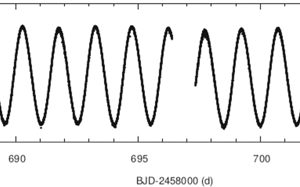A hidden companion for the cepheid V473 Lyr. The study “X-Ray Observations of the Peculiar Cepheid V473 Lyr Identify A Low-mass Companion” of N. R. Evans (Smithsonian Astrophysical Observatory) recently appeared on AJ AJ

Cepheids are pulsating giant stars, whose luminosity varies periodically. This is an important class of stars for several reasons. For instance, the period of their pulsations is related to their intrinsic luminosity. This makes cepheids a class of astronomical “standard candles”, e.g. sources whose intrinsic luminosity can be estimated, allowing us to estimate their distances by comparing intrinsic and observed luminosity. This is an important method to measure distances in the nearby Universe, for instance, for the outer galaxies up to some tens of millions light years.
The pulsations in the cepheids are due to periodic contraction and expansion of the stellar outer layers, related to periodic variation of their opacity. When the luminosity increases, ionization becomes more efficient and thus the abundance of some specific ionized atomic species increases, some of which contribute to the opacity in the outer layers of the star, such as He+2. The atmosphere of the star, thus, absorbs more radiation, rising its temperature and expanding further. However, as it expands, the temperature of the stellar atmosphere decreases, increasing the rate of atomic recombination and thus decreasing opacity. The atmosphere thus cools down efficiently, contracting. The expansion and contraction of the stellar atmosphere produces the periodic variations of stellar luminosity observed in the cepheids.
Cepheids pulsations are observed both in optical and in X-rays. For instances, the X-ray emission of the two cepheid stars δ Cep e β Dor is constant during almost all the pulsation phase, and it sudden increases when the optical emission approaches its maximum. The comparison of optical and X-ray variability can shed some light on how the perturbation propagate from the photosphere to the chromosphere and corona. This motivated a series of observations in X-rays of a group of cepheids with the satellite of the European Space Agency XMM-Newton. The analysis of the X-ray observations of the cepheid V473 Lyr is the subject of the paper: “X-ray Observations of the Peculiar Cepheid V473 Lyr Identify A Low-Mass Companion” of the astronomer Nancy Remage Evans (Smithsonian Astrophysical Observatory), recently appeared on The Astronomical Journal. The X-ray emission of V473 Lyr is found to be constant during the whole pulsation phase, differently than the behaviour observed in other cepheids. This suggests that the detected X-ray emission arises from an unseen companion. From the X-ray spectral analysis, the coronal temperature of the companion is about 7 million degrees, typical of G and K stars at the age of V473 Lyr. Besides, from the analysis of astrometric data from Hipparcos and Gaia, the authors estimated a separation between the two components of 30-300 AU (1AU=150 million km). The astronomer I. Pillitteri (INAF-Astronomical Observatory of Palermo) is one of the co-authors of the paper.
The figure (click here to see the entire figure) shows the optical light curve (e.g.: the variation with time of stellar luminosity) of V473 Lyr, observed with the NASA satellite TESS.
Mario Giuseppe Guarcello ( follow mguarce)
